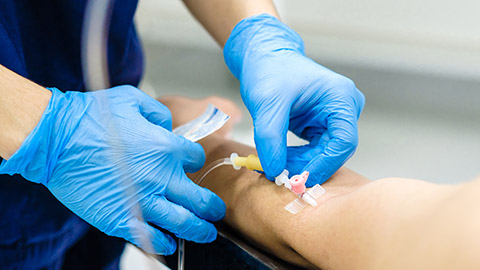
A client is undergoing a series of intravenous iron infusions to treat anemia. Her doctor has cleared her for massage, but her massage therapist still has questions—as they should. What are the cautions or contraindications for someone who needs to supplement iron intravenously? Let’s find out.
Resources: 
Pocket Pathology: /abmp-pocket-pathology-app
Anemia - Iron-Deficiency Anemia | NHLBI, NIH (no date). Available at: https://www.nhlbi.nih.gov/health/anemia/iron-deficiency-anemia (Accessed: 19 October 2022).
Foods High in Iron: Clams, Dark Chocolate, White Beans, and Many More (2019) Healthline. Available at: https://www.healthline.com/health/food-nutrition/foods-high-in-iron (Accessed: 19 October 2022).
Iron Infusion: Benefits, Side Effects, and What to Expect (no date). Available at: https://www.healthline.com/health/iron-infusion (Accessed: 19 October 2022).
Iron infusion: Uses, benefits, and what to expect (2017). Available at: https://www.medicalnewstoday.com/articles/318827 (Accessed: 19 October 2022).
Iron Sucrose (Intravenous Route) Side Effects - Mayo Clinic (no date). Available at: https://www.mayoclinic.org/drugs-supplements/iron-sucrose-intravenous-route/side-effects/drg-20075836 (Accessed: 19 October 2022).
Rossi, E. (2005) ‘Hepcidin - the Iron Regulatory Hormone’, Clinical Biochemist Reviews, 26(3), pp. 47–49.


About Til Luchau and Advanced-Trainings.com:
As a Certified Advanced Rolfer™, Til was on the faculty of the Dr. Ida Rolf Institute® for 20 years, where he served as Coordinator and Faculty Chair of the Foundations of Rolfing Structural Integration program. The author of the Advanced Myofascial Techniques textbook series (which has been translated into 6 languages), his regular Myofascial Techniques and Somatic Edge columns have been featured in Massage & Bodywork magazine since 2009, and (along with Whitney Lowe) he co-hosts the popular Thinking Practitioner Podcast. He is the Director of Advanced-Trainings.com which since 1985 has offered short, credit-approved professional trainings and certification for manual therapists of all types, in person and online.
Website: Advanced-Trainings.com
Email: info@advanced-trainings.com
Facebook: facebook.com/Advanced.Trainings1/
Instagram: instagram.com/tilluchau
YouTube: youtube.com/user/AdvancedTrainings
0:00:00.2 Speaker 1: Join Til Luchau on a floating raft house in Thailand, surrounded by a jungle eco preserve for 10 days of myofascial bodywork, Zoga movement, and restorative learning starting February 20th, 2023. Or, join Til for some powerful at-home learning with his monthly subscription, giving you unlimited access to more than 35 curated classes, including advanced myofascial techniques, movement for body workers, Feldenkrais and more. It's super affordable, and you can pause or cancel at any time. Sign up now at advancedtrainings.com.
0:00:42.4 Ruth Werner: Hey, "I Have a Client Who... " listeners, did you know I have a growing library of NCB approved one-hour online self-paced continuing education courses that you can do any time, anywhere? Well, now you know, current classes include: What's next; COVID-19 Updates for Massage Therapists, and, A Massage Therapist's Introduction to Pharmacology Part One, and brand new, A Massage Therapist's Introduction to Pharmacology Part Two. Classes are $20 each and they confer one hour of continuing education credit. Wanna know more? Visit my website at ruthwerner.com and check it out. Be sure to sign up for my mailing list so you'll never miss a new class.
[music]
0:01:36.8 RW: Hi, and welcome to "I Have a Client Who... " Pathology Conversations with Ruth Werner, the podcast where I will discuss your real life stories about clients with conditions that are perplexing or confusing. I'm Ruth Warner, author of A Massage Therapist's Guide to Pathology, and I have spent decades studying, writing about and teaching about where massage therapy intersects with diseases and conditions that might limit our client's health. We almost always have something good to offer, even with our most challenged clients, but we need to figure out a way to do that safely, effectively and within our scope of practice. And sometimes as we have all learned, that is harder than it looks. Today's "I Have a Client Who... " story comes from a massage therapist with a question I've never considered before, so it gave me a chance to learn a couple of new things, plus I met a hormone I've never heard of, and that was cool, and it goes like this. "Good afternoon, Ruth. Have you done a podcast with a client taking iron infusions for anemia? Was wondering if any contraindications or restrictions, thanks."
0:02:48.4 RW: Well, I asked for more information about this client, and here's what I learned. The client had a stillborn baby at approximately six months, she went through a series of tests and was found to be anemic, she gets iron infusions weekly, has been off iron infusions for three weeks. She has low hemoglobin but is having a couple more infusions starting next week. The doctor gave her the okay for massage on Friday. I was wondering if anyone has worked on a case like this.
0:03:15.5 RW: I get clients seeking massage with some unusual health conditions, I try my best to research before proceeding to get as much help as I can. Once in a while I say no, because fear of hurting them. I've worked on several clients receiving iron infusions with absolutely zero issues, they typically feel much better after an infusion. Right, so first I wanna say how much I appreciate this massage therapist for wanting to be careful and conservative, and secondly, I wanna say thank you for sending me this very interesting story. There are a few ways we can go with this. First, let's talk about iron deficiency anemia and how our body uses and limits iron, and then just a bit about iron infusions and implications about massage therapy. Iron deficiency anemia, this is a situation where iron levels are low and a person lacks a key ingredient on which to build hemoglobin, that's the molecule that fills up our red blood cells. The central part of hemoglobin is iron, low iron means low hemoglobin, and that means not enough red blood cells and there we are, anemia. Females have a much higher risk of developing iron deficiency anemia compared to males because of blood loss during menstrual periods and child birth.
0:04:33.7 RW: But people over 65 also get iron deficiency anemia and people on blood thinners and also those with kidney failure because kidneys secrete the hormone that stimulates the production of new red blood cells, that's erythropoietin or EPO. Signs and symptoms of anemia include paleness and in a dark-skinned person, this would look like a grayish sort of pallor, also fatigue, headaches, poor resistance to cold, dizziness and increased risk for infections, tachycardia as the heart tries to push iron pour blood through the body faster, and... Which may have been an issue for the client in this story, complications with pregnancy. Although she may also have developed it as a result of this stillbirth. Iron deficiency anemia can sometimes be addressed through dietary changes, eating foods rich in iron along with foods high in vitamin C, which makes iron more available for absorption, but for some people, this isn't adequate because they have some digestive system anomalies that make it hard to absorb this vital mineral, or their levels are so very low that they need to increase iron more quickly. It isn't safe to wait for the relatively slow adjustments that come through changing their diet.
0:05:51.4 RW: In these cases, they may need to supplement iron either as an oral supplement, and if they have digestive issues, this won't work well, or through infusions, a process that introduces iron directly into the bloodstream, bypassing the GI tract. Before we talk about that, I'd like to take us on a short detour into the world of iron regulation. We all know that iron is vital, right? It bonds well to oxygen, so our red blood cells, which are chuck-full of hemoglobin, which is built around iron, can deliver oxygen to ourselves. It's also part of myoglobin, a molecule found in striated muscle cells, the ones in our skeletal muscles and in our heart. And myoglobin stores oxygen on site so those cells can use it as they need it. I get a kick out of the fact that it is iron that turns our blood bright red when it's exposed to the air. When you give blood either as a donation or for blood tests, it goes into a vacuum sealed container. And if you're the kind of person who likes to watch instead of looking away, you will have noticed that this blood is very dark, and that makes sense, it's usually venous blood, which is lower in oxygen and therefore a darker color. But, if it were exposed to the oxygen in the air, it would turn much brighter, which is why when we bleed from everyday injuries like getting too close to the cheese grater or shaving or pruning rose bushes, our blood isn't that dark, dark red.
0:07:26.2 RW: It's bright, it's oxygenated. Thanks, hemoglobin and iron. But is it possible to have too much iron? Yes, yes it is. And there are some specific disorders related to that like hemochromatosis and others. But what if someone binges on super iron-rich foods like liver and lentils and spinach and... Oh, I didn't know this, dark chocolate? Can we overdose on iron? It's unlikely because our bodies are pretty picky about how much iron we hold on to. Under normal circumstances, we secrete an iron-regulating hormone from the liver, it's called hepcidin. Interestingly, this hormone was originally thought to be for antibacterial action, it was only in 2001 that we discovered its role in iron metabolism. There's a quote from a 2005 paper on this topic, "The rate of iron e-flux into the plasma depends primarily on the plasma level of hepcidin, when iron levels are high, the synthesis of hepcidin increases and the release of iron from enterocytes and macrophages is diminished. Conversely, when iron stores drop, the synthesis of hepcidin is down-regulated and these cells release more iron." Hepcidin, a whole new hormone to me. Cool, right? Or maybe I'm just easily amused.
0:09:02.2 RW: In any case, so here we are with a client who has iron deficiency anemia, she's recently gone through a difficult time with the loss of her pregnancy at six months. Now she's having iron infusions and would like to receive massage. Her doctor is on board, but her doctor may or may not be familiar with whatever kinds of risks massage therapy might pose in a situation like this. I looked up risks and adverse events connected with iron infusions, and I'm happy to report there isn't that much that's common, here's the list that is a compilation of what I found from the Mayo Clinic, the Cleveland Clinic, and another source I really like called Medical News Today. The most common side effects related to iron infusions include constipation or diarrhea, nausea, dizziness or lightheadedness when getting up suddenly from a lying or sitting position, and bloating or swelling in the face, arms, hands, lower legs or feet. And these things tend to be quite temporary. Much rarer side effects include blurred vision, chest pain or tightness in the chest, confusion, difficult or labored breathing, headache, nervousness, pounding in the ear, slow or fast heartbeat, sweating, tingling in the hands or feet, skin problems including rash, low blood pressure and anaphylaxis, a severe reaction that can include difficulty breathing, itching or a rash over the entire body.
0:10:31.6 RW: Because iron infusions have a low but not zero chance of creating some unpleasant side effects, they are typically done quite slowly over the course of a few hours, and this allows the medical team to recognize signs of poor tolerance before they get too extreme. And from what I've been able to find, this isn't a typical problem, most people tolerate iron infusions well and feel much better afterwards. So, what does this mean for a massage? Well, when I first got this message, I was a bit concerned about maybe an increased risk of clotting right after an infusion because the blood is thicker. That turned out to be a non-issue. In my opinion, simply asking about any side effects related to iron infusions and referring anything alarming, like persistent chest pain or blurred vision or signs of anaphylaxis back to their doctor is probably going to keep everyone safe. So I'm happy to suggest to this massage therapist and their client, go forth and massage, this client has been through a rough time, and if your work can help her feel more herself, then you are in a position to do her a lot of good.
0:11:46.5 RW: Maybe ask her to watch for dizziness or faintness, especially right after your session, and to make sure she is awake, alert and ready to manage her day before she leaves your workplace. I wanna thank today's contributor again for giving me something new to learn about, and I'm curious to know if you have ever worked with clients who get iron infusions and what you might have found out about that. So keep those "I Have a Client Who... " stories coming.
0:12:14.1 RW: Hey everybody, thanks for listening to "I Have a Client Who... " Pathology Conversations with Ruth Werner. Remember you can send me your "I Have a Client Who... " stories to, ihaveaclientwho@abmp.com, that's ihaveaclientwho, all one word, all lower case, @abmp.com. I can't wait to see what you send me and I'll see you next time.
[music]